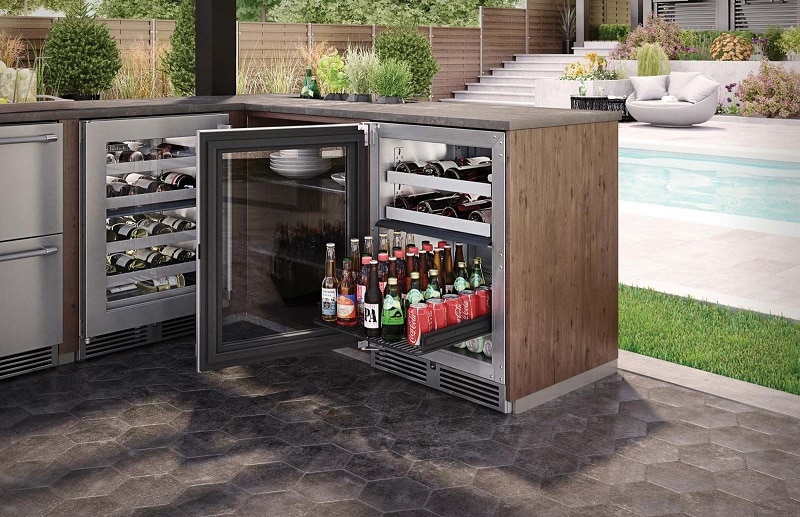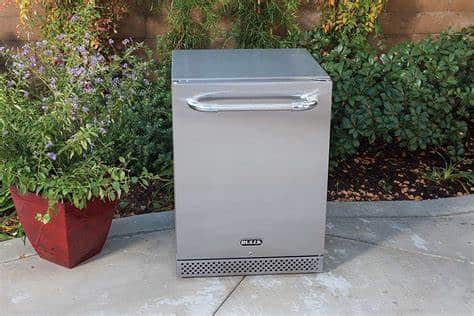A freezer is a great appliance that allows you to store and preserve food for a long time. But what if you don’t have enough space in your kitchen or basement for a freezer? Can you put a freezer in a shed or other outdoor location? In this post, we’ll explore the pros and cons of putting a freezer in a shed, and what factors you need to consider before doing so. We’ll also answer some common questions and share some tips on how to choose and maintain an outdoor freezer.
Yes, you can put a freezer in a shed, but you have to be careful and follow some precautions. Putting a freezer in a shed can expose it to extreme temperatures, humidity, dust, pests, and theft. You need to make sure that your freezer is suitable for outdoor use, that your shed is well-ventilated and protected, and that your freezer is properly installed and maintained.
How to Choose a Freezer for Outdoor Use
Not all freezers are designed to work well in outdoor conditions. You need to choose a freezer that has the right climate class, size, type, and features for your shed. Here are some things to look for when choosing a freezer for outdoor use:
- Climate class: The climate class of a freezer indicates the minimum and maximum ambient temperature range that the freezer can operate in. You need to choose a freezer that matches the temperature of your shed throughout the year. For example, if your shed gets very cold in winter or very hot in summer, you need a freezer that can handle those extremes. The table below shows the different climate classes and their temperature ranges:
| Climate Class |
Temperature Range (°C) |
Temperature Range (°F) |
| Tropical (T) |
16-43 |
61-109 |
| Subtropical (ST) |
16-38 |
61-100 |
| Normal (N) |
16-32 |
61-90 |
| Subnormal (SN) |
10-32 |
50-90 |
You can find the climate class of a freezer on its label, manual, or online.
- Size: The size of a freezer depends on how much food you want to store and how much space you have in your shed. You should measure the dimensions of your shed and the available floor space before buying a freezer. You should also consider the door clearance and ventilation space around the freezer. A good rule of thumb is to allow about 1.5 cubic feet of freezer space per person in your household.
- Type: The type of a freezer refers to its shape and design. There are two main types of freezers: chest freezers and upright freezers. Chest freezers are horizontal boxes with lids that open from the top. They are more energy-efficient, spacious, and better at retaining cold air than upright freezers. However, they are also heavier, harder to organize, and require more floor space than upright freezers. Upright freezers are vertical cabinets with doors that open from the front. They are more convenient, accessible, and easier to organize than chest freezers. However, they are also less energy-efficient, less spacious, and more prone to frost buildup than chest freezers.
- Features: The features of a freezer refer to its functions and accessories that enhance its performance and convenience. Some features to look for when choosing a freezer for outdoor use are:
- Frost-free: A frost-free feature prevents ice from forming on the walls or coils of the freezer, which can reduce its efficiency and capacity. It also eliminates the need for manual defrosting, which can be time-consuming and messy.
- Temperature control: A temperature control feature allows you to adjust the temperature of the freezer according to your preferences and needs. It also helps maintain a consistent temperature inside the freezer regardless of the external conditions.
- Lock: A lock feature allows you to secure the door of the freezer with a key or a code, which can prevent unauthorized access or theft of your food.
- Alarm: An alarm feature alerts you when the door of the freezer is left open or when the temperature inside the freezer rises above or falls below a certain level, which can prevent food spoilage or damage.

How to Install and Maintain an Outdoor Freezer
Once you have chosen a suitable freezer for outdoor use, you need to install and maintain it properly to ensure its optimal performance and longevity. Here are some tips on how to install and maintain an outdoor freezer:
- Install it in a shaded and sheltered location: You should install your freezer in a shaded and sheltered location in your shed, away from direct sunlight, heat sources, moisture, dust, or pests. This will help prevent overheating, freezing, rusting, or infestation of your freezer.
- Install it on a level and stable surface: You should install your freezer on a level and stable surface in your shed, such as a concrete slab or a wooden platform. This will help prevent tilting, vibration, or movement of your freezer, which can affect its operation and safety.
- Install it with enough clearance and ventilation: You should install your freezer with enough clearance and ventilation around it, according to the manufacturer’s instructions. This will help ensure proper airflow and heat exchange around the freezer, which can improve its efficiency and performance.
- Plug it into a dedicated and grounded outlet: You should plug your freezer into a dedicated and grounded outlet in your shed, preferably with a surge protector or a circuit breaker. This will help prevent electrical shock, fire, or damage to your freezer due to power fluctuations or surges.
- Clean and inspect it regularly: You should clean and inspect your freezer regularly to keep it in good condition and prevent any problems. You should wipe the interior and exterior of your freezer with a damp cloth and mild detergent to remove any dust, dirt, spills, or stains. You should also check the door seals, hinges, coils, vents, and wires for any cracks, leaks, or wear and tear. You should replace any damaged or worn-out parts as soon as possible.
- Defrost it as needed: If your freezer is not frost-free, you should defrost it as needed to prevent ice buildup on the walls or coils of the freezer, which can reduce its efficiency and capacity. You should defrost your freezer when the ice layer reaches about one-fourth of an inch thick. To defrost your freezer, you should unplug it, remove the food, and let the ice melt naturally or use a hairdryer or a fan to speed up the process. You should also clean and dry the interior of your freezer before plugging it back in.

FAQs
Q: Can you put a freezer in an unheated shed?
A: Yes, you can put a freezer in an unheated shed, as long as the temperature of the shed does not fall below or rise above the climate class of the freezer. You should also make sure that the shed is well-insulated, ventilated, and protected from extreme weather conditions.
Q: Can you put a freezer in a damp shed?
A: No, you should not put a freezer in a damp shed, as this can cause rusting, corrosion, or mold growth on your freezer. You should make sure that the shed is dry, well-ventilated, and free from moisture or humidity.
Q: Can you put a freezer in a metal shed?
A: Yes, you can put a freezer in a metal shed, as long as the metal shed is sturdy, secure, and suitable for outdoor use. You should also make sure that the metal shed is well-insulated, ventilated, and protected from extreme temperatures, moisture, dust, pests, and theft.
Conclusion
A freezer is a great appliance that allows you to store and preserve food for a long time. But if you don’t have enough space in your kitchen or basement for a freezer, you may wonder if you can put a freezer in a shed or other outdoor location. The answer is yes, but you have to be careful and follow some precautions. You need to choose a freezer that is suitable for outdoor use, that has the right climate class, size, type, and features for your shed. You also need to install and maintain your freezer properly to ensure its optimal performance and longevity. By following the tips and advice in this post, you can enjoy having an outdoor freezer in your shed without any problems.


